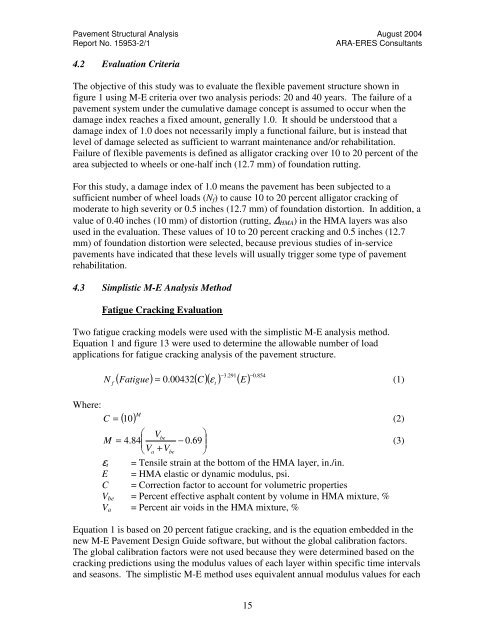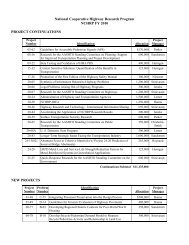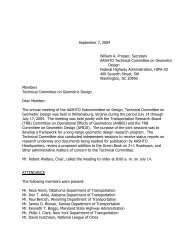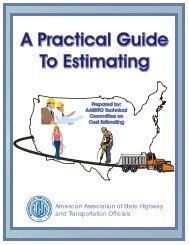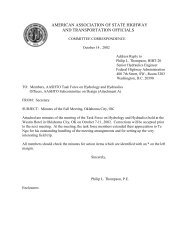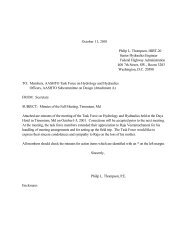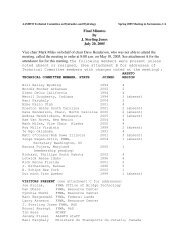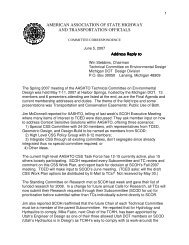Pavement Structural Analysis of the Design Recommendations for ...
Pavement Structural Analysis of the Design Recommendations for ...
Pavement Structural Analysis of the Design Recommendations for ...
Create successful ePaper yourself
Turn your PDF publications into a flip-book with our unique Google optimized e-Paper software.
<strong>Pavement</strong> <strong>Structural</strong> <strong>Analysis</strong> August 2004<br />
Report No. 15953-2/1 ARA-ERES Consultants<br />
4.2 Evaluation Criteria<br />
The objective <strong>of</strong> this study was to evaluate <strong>the</strong> flexible pavement structure shown in<br />
figure 1 using M-E criteria over two analysis periods: 20 and 40 years. The failure <strong>of</strong> a<br />
pavement system under <strong>the</strong> cumulative damage concept is assumed to occur when <strong>the</strong><br />
damage index reaches a fixed amount, generally 1.0. It should be understood that a<br />
damage index <strong>of</strong> 1.0 does not necessarily imply a functional failure, but is instead that<br />
level <strong>of</strong> damage selected as sufficient to warrant maintenance and/or rehabilitation.<br />
Failure <strong>of</strong> flexible pavements is defined as alligator cracking over 10 to 20 percent <strong>of</strong> <strong>the</strong><br />
area subjected to wheels or one-half inch (12.7 mm) <strong>of</strong> foundation rutting.<br />
For this study, a damage index <strong>of</strong> 1.0 means <strong>the</strong> pavement has been subjected to a<br />
sufficient number <strong>of</strong> wheel loads (Nf) to cause 10 to 20 percent alligator cracking <strong>of</strong><br />
moderate to high severity or 0.5 inches (12.7 mm) <strong>of</strong> foundation distortion. In addition, a<br />
value <strong>of</strong> 0.40 inches (10 mm) <strong>of</strong> distortion (rutting, ∆HMA) in <strong>the</strong> HMA layers was also<br />
used in <strong>the</strong> evaluation. These values <strong>of</strong> 10 to 20 percent cracking and 0.5 inches (12.7<br />
mm) <strong>of</strong> foundation distortion were selected, because previous studies <strong>of</strong> in-service<br />
pavements have indicated that <strong>the</strong>se levels will usually trigger some type <strong>of</strong> pavement<br />
rehabilitation.<br />
4.3 Simplistic M-E <strong>Analysis</strong> Method<br />
Fatigue Cracking Evaluation<br />
Two fatigue cracking models were used with <strong>the</strong> simplistic M-E analysis method.<br />
Equation 1 and figure 13 were used to determine <strong>the</strong> allowable number <strong>of</strong> load<br />
applications <strong>for</strong> fatigue cracking analysis <strong>of</strong> <strong>the</strong> pavement structure.<br />
Where:<br />
−3.<br />
291 −0.<br />
854<br />
( Fatigue)<br />
= 0.<br />
00432(<br />
C)(<br />
) ( E)<br />
N t<br />
f ε (1)<br />
( ) M<br />
C = 10<br />
(2)<br />
⎛ Vbe<br />
M = 4.<br />
84<br />
⎜<br />
⎝Va<br />
+ Vbe<br />
⎞<br />
− 0.<br />
69<br />
⎟<br />
⎠<br />
(3)<br />
εt = Tensile strain at <strong>the</strong> bottom <strong>of</strong> <strong>the</strong> HMA layer, in./in.<br />
E = HMA elastic or dynamic modulus, psi.<br />
C = Correction factor to account <strong>for</strong> volumetric properties<br />
Vbe = Percent effective asphalt content by volume in HMA mixture, %<br />
Va = Percent air voids in <strong>the</strong> HMA mixture, %<br />
Equation 1 is based on 20 percent fatigue cracking, and is <strong>the</strong> equation embedded in <strong>the</strong><br />
new M-E <strong>Pavement</strong> <strong>Design</strong> Guide s<strong>of</strong>tware, but without <strong>the</strong> global calibration factors.<br />
The global calibration factors were not used because <strong>the</strong>y were determined based on <strong>the</strong><br />
cracking predictions using <strong>the</strong> modulus values <strong>of</strong> each layer within specific time intervals<br />
and seasons. The simplistic M-E method uses equivalent annual modulus values <strong>for</strong> each<br />
15


